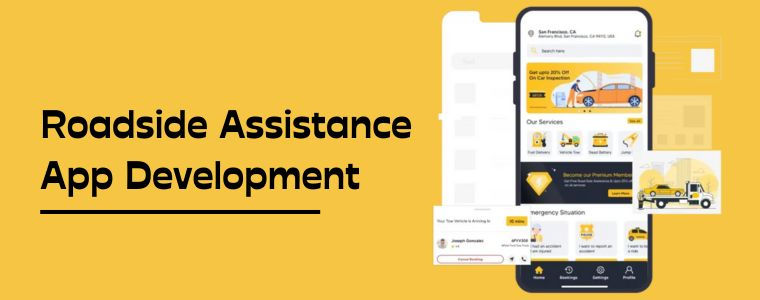10 Steps to Create a Scalable Roadside Assistance App That Drives Growth
- steffanbobot1509
- Sep 18
- 4 min read

Building a roadside assistance app is a strategic move that can redefine how service providers connect with customers in need. Whether you’re aiming to develop an on-demand roadside assistance app or an Uber-like roadside assistance app, the goal remains consistent: to create a scalable, reliable platform that drives growth for your business. Successful roadside assistance app development requires thoughtful planning, a clear understanding of the market, and a structured approach to building features that meet customer needs efficiently.
This article walks you through the critical steps to create a scalable roadside assistance app that not only meets user expectations but also positions your business for long-term growth.
Understanding the Market and User Needs
Before diving into development, it’s crucial to grasp the unique challenges and expectations of your target users. Roadside assistance customers often face stressful situations—they want fast, dependable help without any confusion. Understanding the pain points, such as wait times, unclear pricing, or unreliable service, helps inform which features are vital in your app.
Many successful apps in this sector offer transparency in pricing, real-time tracking of service providers, and easy payment methods. Researching competitors and analyzing customer reviews of existing apps will provide insights to differentiate your solution.
Step 1: Define Clear Business Objectives
The foundation of your roadside assistance app development lies in establishing clear, measurable business objectives. Are you building this app to reduce operational costs? Increase customer engagement? Expand your service area? Each objective will influence the app’s features and scalability needs.
For example, if your goal is to increase service efficiency, your app must prioritize seamless communication between drivers and assistance providers. Defining objectives early ensures alignment between your technical team and business goals.
Step 2: Choose the Right Technology Stack
Selecting the technology stack is a critical decision affecting scalability, performance, and maintainability. For an on-demand app development company, considerations include:
Backend frameworks that support real-time updates and notifications
Scalable cloud infrastructure (like AWS or Google Cloud)
Mobile platforms: Native (iOS and Android) or cross-platform frameworks (Flutter, React Native)
APIs for GPS tracking, payment gateways, and messaging
The chosen technologies should support your current needs and future growth, allowing for easy integration of new features.
Step 3: Focus on User Experience (UX) Design
A streamlined user experience reduces friction during stressful moments when customers need roadside assistance most. Intuitive navigation, quick access to help requests, and clear status updates are essential.
Design your app to minimize the steps users take to request assistance. Consider features like automated location detection, predefined service options (towing, tire change, battery jump-start), and an in-app chat or call option for instant communication.
Step 4: Build Robust Service Provider Features
Your app must equally serve the roadside assistance professionals. Features like job alerts, route optimization, service history, and easy availability updates empower providers to work efficiently.
A well-designed provider interface improves response times and service quality, which directly impacts customer satisfaction and growth. Allow providers to manage their profiles and receive payments through the app to streamline operations.
Step 5: Integrate Real-Time Tracking and Notifications
Real-time tracking is a game-changer in roadside assistance. Customers want to know exactly when help will arrive. Integrate GPS tracking so users can monitor the service provider’s route live.
Push notifications keep users informed about request status changes, estimated arrival times, and any delays. These features improve transparency, reduce anxiety, and build trust.
Step 6: Implement Secure and Flexible Payment Systems
Offering multiple payment options increases convenience and customer satisfaction. Integrate secure payment gateways that accept credit cards, digital wallets, and in some cases, cash-on-delivery options.
Ensure compliance with data security standards and provide clear invoicing within the app. Transparency in billing reduces disputes and enhances the overall experience.
Step 7: Build Scalable Backend Architecture
Scalability is crucial for handling growth without sacrificing performance. Design your backend to accommodate increasing users, service providers, and data volume.
Utilize microservices architecture, containerization (Docker, Kubernetes), and cloud services to dynamically scale resources based on demand. This approach prevents downtime and ensures smooth operations even during peak periods.
Step 8: Prioritize Security and Compliance
Handling sensitive user data and payment information requires strict security measures. Implement encryption protocols, secure authentication methods, and regular security audits.
Ensure compliance with relevant regulations, such as GDPR or PCI DSS, depending on your target markets. Building trust through security will protect your reputation and support sustainable growth.
Step 9: Test Thoroughly Before Launch
Extensive testing is essential to catch bugs and ensure the app performs well under different conditions. Include functional testing, performance testing, usability testing, and security testing in your quality assurance plan.
Pilot testing with a limited user base or geographic area can provide valuable feedback before a full-scale launch.
Step 10: Plan for Continuous Improvement and Support
Launching the app is just the beginning. Establish processes for monitoring performance, gathering user feedback, and regularly updating the app with improvements and new features.
Invest in customer support and training for service providers to maintain high service standards. A commitment to continuous improvement will help your app evolve with changing market demands and technological advancements.
Conclusion
Creating a roadside assistance app that drives growth involves a combination of strategic planning, user-centric design, and scalable technology choices. By following these 10 steps, you can build a platform that meets the critical demands of on-demand roadside help while positioning your business for expansion.
Partnering with an experienced on demand app development company can ease the technical complexities, but understanding the full process ensures better collaboration and results. Whether you aim to develop an Uber-like roadside assistance app or a specialized service platform, focusing on scalability, security, and user experience will help your app stand out in this competitive market.
Building a robust roadside assistance app is a significant investment in your business’s future—one that can transform how services are delivered and experienced on the road.



Comments